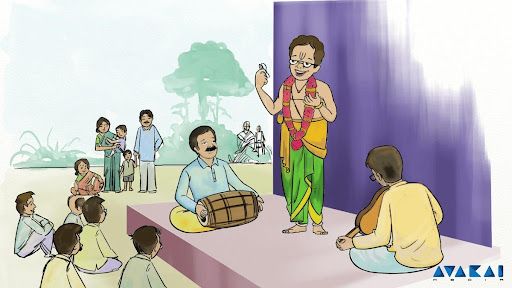For smooth Ad free experience
For smooth Ad free experience
Step back in time and experience the ancient art of Harikatha, a traditional form of storytelling and devotional discourse that will transport you to a world of spiritual teachings and moral lessons. Immerse yourself in the captivating performances of skilled kathakars as they weave together singing, acting, and dialogue to bring religious stories to life.

History Of Harikatha
Harikatha, also known as Hari-katha or Harikatha Kalakshepam, is an ancient Indian tradition of storytelling that has been passed down for centuries. This unique art form combines music, storytelling, and devotional singing to convey moral and spiritual teachings to audiences.
Harikatha has its roots in the Bhakti movement of medieval India, which emphasized devotion and the personal relationship between an individual and the divine. The stories and teachings of Harikatha are meant to inspire, educate, and entertain while promoting spiritual growth and self-improvement. In this article, we will explore Harikatha's history, cultural significance, and ongoing legacy.
The word "Harikatha" is a combination of two words: "Hari," which refers to Lord Vishnu or Lord Krishna, and "katha," which means story or discourse. Harikatha is a form of discourse that focuses on the stories and teachings of Lord Vishnu or Lord Krishna, intending to inspire devotion and spiritual growth in listeners.
The Bhakti movement of medieval India emerged as a response to the rigid caste system and the emphasis on ritualistic practices in traditional Hinduism. Harikatha was one of the many forms of devotional expression that emerged during this time, and it quickly gained popularity among the common people.
Harikatha performances typically involve a solo performer, known as a Harikatha exponent, who tells stories and sings devotional songs while playing a musical instrument such as the harmonium or the tambura. The stories are usually drawn from Hindu mythology, the Puranas, and the Bhagavad Gita.
One of the unique features of Harikatha is the emphasis on the audience's participation. The Harikatha exponent often encourages the audience to ask questions, share their own experiences, and engage in discussions about the presented stories and teachings. This interactive element of Harikatha helps create a deeper connection between the performer and the audience and allows for a more personalized and meaningful experience.
The different regions and cultures of India have heavily influenced Harikatha. Different regions have variations in terms of the stories, the style of music, and the instruments used. For example, in the South Indian state of Andhra Pradesh, Harikatha is performed mainly by women and is called "Amma Harikatha".
The performance usually includes a combination of singing, instrumentation, and narration and often includes religious themes and stories from Hindu mythology. The performer, known as a Harikatha exponent or kathakar, typically sits on a stage or platform and tells stories, sings devotional songs, and recites verses from religious texts accompanied by music. The audience is usually seated on the floor and may include men and women of all ages.
Several notable exponents have kept the Harikatha tradition alive over the centuries. Some of the most famous Harikatha exponents include Gauramma, the first woman to perform Harikatha in the 19th century, and Parupalli Ramakrishnayya Pantulu, known for his ability to convey complex philosophical concepts in a simple and accessible way.
This ancient art form has been passed down through generations and is still widely enjoyed by people of all ages today. However, in recent years, the popularity of Harikatha has been on the decline. The number of kathakars, or performers, has diminished as young people need to show more interest in taking up this art form. Many traditional kathakars are now retired or nearing retirement age. This has led to a shortage of skilled performers and has made it difficult for audiences to find live Harikatha performances.
Another reason for the decline in popularity is the emergence of other forms of entertainment, such as television, movies, and the internet. These new forms of entertainment have made it difficult for Harikatha to compete in audience appeal and accessibility.
Despite these challenges, many people are still passionate about preserving the tradition of Harikatha. Some kathakars have started to use modern technology to reach a wider audience. They are using YouTube and other social media platforms to share their performances and teachings with people worldwide.
Additionally, some organizations and groups are working to promote Harikatha and to raise awareness of its cultural significance. They organize events and workshops to bring kathakars and audiences together and encourage young people to learn the art form.
In conclusion, Harikatha is a unique and captivating art form that has enthralled audiences for generations. This traditional storytelling and devotional discourse have been passed down through the years, keeping alive the rich cultural heritage of Tamil Nadu.
Harikatha is not just an art form but a medium to educate, entertain and enlighten people on moral and spiritual values. It's a tradition and a way to preserve our culture and heritage. In this fast-paced world, the relevance of Harikatha is even more important as it provides a much-needed break from the monotony of daily life and helps people connect with their roots and culture.
0
You might be interested in reading more from
